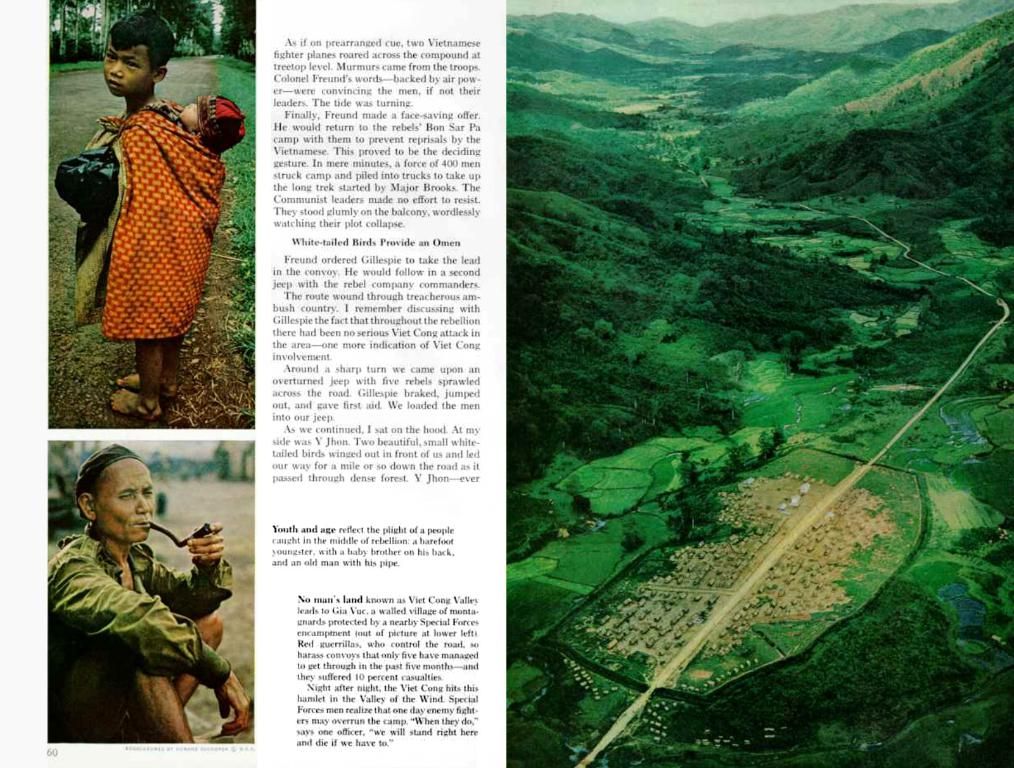China proposes managing weather conditions utilizing drones, allegedly capable of influencing rainfall and promoting favorable atmospheric conditions.
Taming the Elements: China's Climate Modification Quest
China's mission to control weather conditions has moved from science fiction dreams to concrete ambitions. The recent experimental weather manipulation in Xinjiang, showcasing the effectiveness of climate modification technologies, is a telling sign [1]. Utilizing a minuscule amount of silver iodide, equivalent to a travel mug's content, drones distributed the chemical over an expansive 8,000 km² region, causing a 4% increase in rainfall within a single day and filling approximately 30 Olympic-sized pools [2].
This experiment, headed by the Chinese Meteorological Administration (CMA), made use of medium-sized drones that scaled heights of 5,500 meters [2]. Through four consecutive flights over the Bayanbulak grasslands, they released silver iodide, marking the beginning of China's prominent role in the global climate modification landscape. By 2025, it's estimated that 5.5 million square kilometers (around 60% of the national territory) will be under the CMA's climate-altering services [2]. These services encompass stimulating rain and snow, reducing hail, and dissipating clouds, with 580,000 square kilometers dedicated solely to preventing hail damage [2].
Beyond isolated experiments, China's atmospheric interventions serve a larger agenda focused on enhancing food security, supporting agriculture, combating drought, preventing wildfires, and improving urban air quality [3]. The core of China's atmospheric modifications hinges on cloud seeding, or cloud fertilization, a method that involves dispersing chemicals within clouds to encourage the formation of rain or snow [3]. This process can be executed from the ground using rockets, aircraft, or drones.
It's long been speculated that cloud fertilization coincides with significant events to ensure clear skies and minimal atmospheric pollution, such as political anniversary parades or visits from foreign leaders [3]. Weather manipulation activities, often referred to as "blueskying," are typically carried out in conjunction with social changes that precede these events, like factory closures and construction halts [3]. For instance, weather modification tactics were employed during the APEC summit in 2014 and the centennial of the Communist Party in 2021 [3].
The prolific use of these weather modification technologies doesn't come without controversy. Environmental concerns center on the potential negative impacts on ecosystem health and water quality from prolonged and extensive chemical usage [3]. Geopolitically, countries neighboring China worry that its atmospheric operations could impact the weather patterns of neighboring regions, although scientific evidence of cross-border effects remains largely absent [3].
[1] https://www.sciencedirect.com/science/article/pii/S2214629619301853[2] https://www.scmp.com/news/china/science/article/3096330/scientific-breakthrough-china-has-started-manipulating-the-climate[3] https://www.desertoasimeteorology.net/journal/index.php/do/article/view/110[4] https://www.mic.com/p/chinas-weather-manipulation-seems-to-be-working-but-at-what-cost-30289952[5] https://www.reuters.com/article/us-china-weather-pollution-idUSKBN27D136
- The average precipitation increase in Xinjiang, due to China's climate modification experiment, was approximately 4%, equivalent to filling 30 Olympic-sized pools.
- China's climate-altering services, as planned by 2025, are expected to cover around 60% of the national territory, primarily focusing on stimulating rain and snow, reducing hail, and dissipating clouds.
- In environmental science, there are concerns about the potential negative effects of prolonged and extensive chemical usage on ecosystem health and water quality.
- China's use of weather modification technologies, such as cloud seeding, has raised geopolitical concerns among neighboring countries, with fears that these operations could impact neighboring regions' weather patterns.
- Financing and technological advancements are essential for the development and refinement of climate-change mitigation strategies in the industrial sector.
- The impact of atmospheric interventions on urban air quality, agriculture, food security, and the prevention of wildfires is a significant aspect of environmental science in China's climate-change battle.








